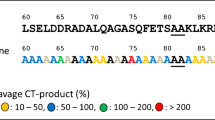Abstract
The culture supernatant of Clostridium botulinum type C, concentrated by addition of RNA, acid precipitation and subsequent protamine treatment was used as starting material for rapid purification of L toxin (mol. wt. ca. 500K) and M toxin (mol. wt. ca. 350K) of C1 neurotoxin by ion-exchange chromatography on a Mono S column by fast performance liquid chromatography (FPLC). L and M toxins were highly purified further by gel permeation chromatography through a TSK G3000SW column at pH 6.0 by high performance liquid chromatography (HPLC). Purified S toxin (mol. wt. ca. 150K, Cl neurotoxin without a nontoxic component) was then obtained from L toxin rapidly by gel permeation chromatography at pH 7.3 through a TSK G3000SW column by HPLC. Purified S toxin was also obtained rapidly from M and L toxins by ion-exchange chromatography on a Mono Q column at pH 8.0 using an FPLC system. The purified preparations of L, M and S toxins gave single bands on conventional polyacrylamide gel electrophoresis, and had specific activities of 2.8, 6.7, and 14–21 × 107 LD50/mg N, respectively, in mice. On immunoelectrophoresis, purified S toxin gave a single arc against anti-crude toxin serum. The yield of toxicity as L and M toxins was 73.1% (32.5% as L toxin and 40.6% as M toxin) from the protamine-treated concentrated culture supernatant. The recovery of toxicity as S toxin from purified L or M toxin was almost 100% (97.6–100% of L toxin and 97.5% of M toxin). These procedures provide a rapid method for purifying L and M toxins, which have stable toxicities. The method will also be very useful for rapid preparation of the toxic component (S toxin) of C1 neurotoxin, which is unstable, in small amounts from the L and M toxins just before its use in experiments.
Similar content being viewed by others
References
Iwasaki M., and Sakaguchi G. (1978): Acid precipitation of Clostridaim botulinum type C and D toxins from whole culture by addition of ribonucleic acid as a precipitation aid. -Infect. Immun., 19: 749–751.
Kondo H., Shimizu T., Kubonoya M., Izumi N., Takahashi M. and Sakaguchi G. (1984): Titration of botulinum toxins for lethal toxicity by intravenous injection into mice. -Jpn. J. Med. Sci. Biol. 37: 131–135.
Kurazono H., Shimozawa K., Hosokawa M. and Sakaguchi G. (1985): Procedures for large-scale production and purification of Clostridium botulinum C1 toxin for preparation of toxoid. -FEMS Microbiol, Lett. 30: 47–51.
Kurazono H., Shimozawa K., Sakaguchi G., Takahashi M., Shimuzu T. and Kondo H. (1985): Botulism among penned pheasants and protection by vaccination with Cl toxoid. -Res. Vet, Sci. 38: 104–108.
Lowry O.H., Rosebrough N.J., Farr A.L. and Randoll R.J. (1951): Protein measurement with the Folin phenol reagent. -J. Biol. Chem. 193: 265–275.
Matsuda M. and Yoneda M. (1977): Antigenic substructure of tetanus neurotoxin. -Biochem. Biophys. Res. Commun. 77: 268–274.
Matsuda M., Sugimoto N., Ozutsumi K. and Hirai T. (1982): Acute botulinum-like intoxication by tetanus neurotoxin in mice. -Biochem. Biophys. Res. Commun. 104: 799–805.
Miyazaki S., Iwasaki M. and Sakaguchi G. (1977): Clostridium botulinum type D toxin: Purification, molecular structure, and some immunological properties. -Infect, Immun. 17: 395–401
Ohishi I. and Sakaguchi G. (1980): Oral toxicities of Clostridium botulinum type C and D toxins of different molecular sizes. -Infect. Immun. 28: 303–309.
Reisfeld R.A., Lewis U.J. and Williams D.E. (1962): Disk electrophoresis of basic proteins and peptides on polyacrylamide gels. -Nature 195: 281–283.
Sakaguchi G. (1983): Clostridium botulinumn toxins. -Pharmac. Ther. 19: 165–194.
Syuto B. and Kubo S. (1977): Isolation and molecular size of Clostridium botulinum type C toxin. -Appl. Environ. Microbiol. 33: 400–405.
Syuto B, and Kubo S. (1981): Separation and characterization of heavy and light chains from Clostridium botulinum type C toxin and their reconstitution. -J. Biol. Chem. 256: 3712–3717.
Weber K, and Osborn M. (1969): The reliability of molecular weight determinations by dodecyl sulfate-polyacrylamide gel electrophoresis. -J. Biol. Chem. 244: 4406–4412.
Author information
Authors and Affiliations
Rights and permissions
About this article
Cite this article
Matsuda, M., Ozutsumi, K., Pei-Ying, D. et al. Rapid method for purification of Clostridium botulinuh type C neurotoxin by High Performance Liquid Chromatography (HPLC ). Eur J Epidemiol 2, 265–271 (1986). https://doi.org/10.1007/BF00419490
Published:
Issue Date:
DOI: https://doi.org/10.1007/BF00419490




